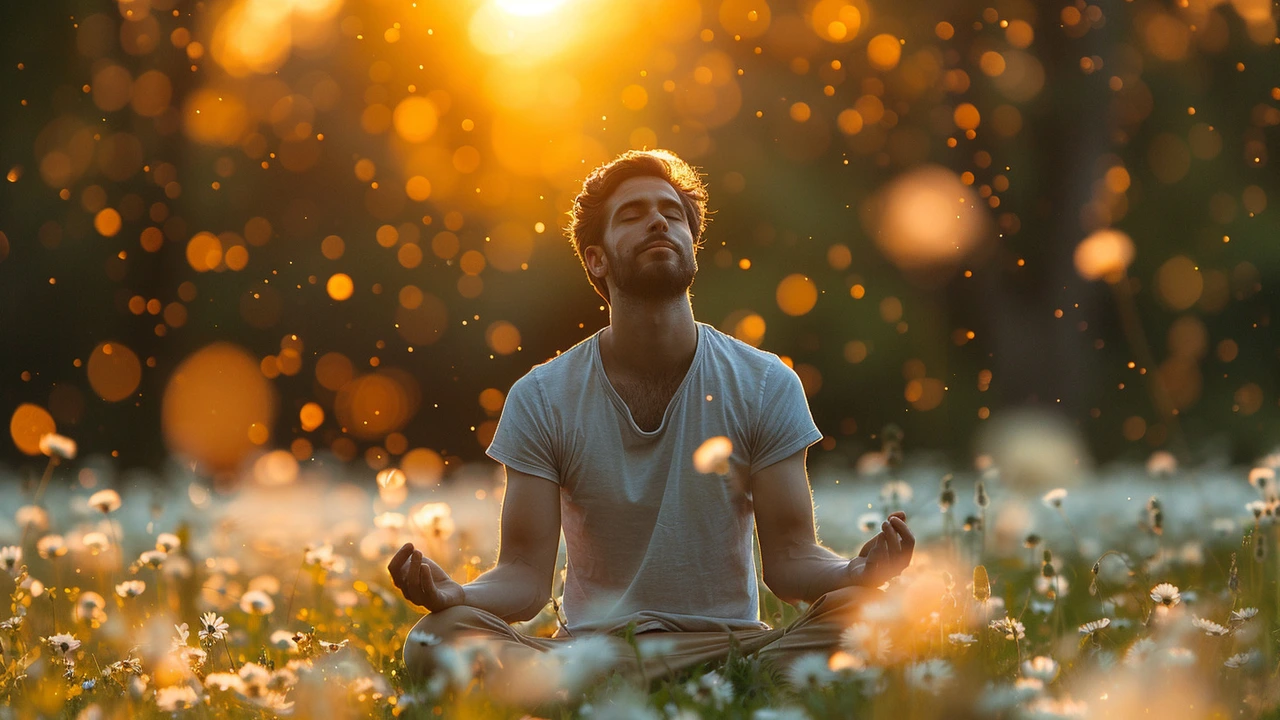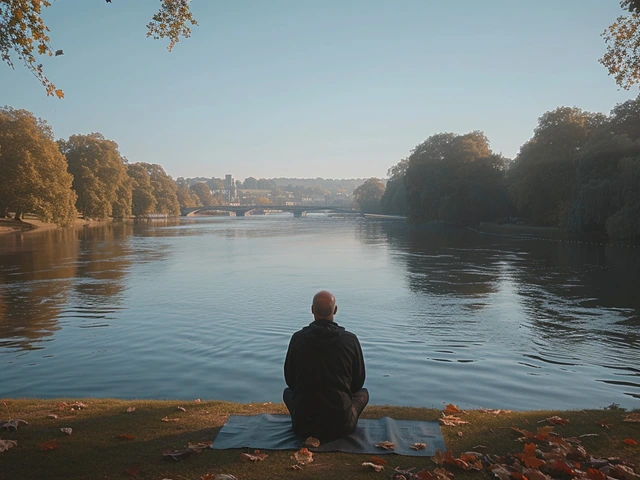
Meditation is more than just a way to relax; it's a pathway to profound spiritual depths. It alters our basic perception of self and the universe, a pinnacle often referred to as spiritual awakening. Each meditative journey is unique, yet they all lead towards a similar understanding of interconnectedness and inner peace.
This knowledge blossoms not through intense effort, but through the gentle, consistent practice of awareness. Whether seated in silence or moving through the motions of daily-life-as-practice, meditation provides keys to the doors of insight.
- Understanding Meditation
- Techniques for Beginners
- Advanced Meditation Practices
- The Benefits of Regular Practice
- Incorporating Meditation into Daily Life
Understanding Meditation
Meditation is a practice as ancient as history itself, yet its fundamental aim remains the same - to bring about a state of peace and heightened awareness. Originating from the sacred traditions of the East, meditation has swept across the globe, gaining traction as a powerful tool for mental health and spiritual growth. It centers on the cultivation of a focused, tranquil mind, and is often used as a technique to manage stress and deepen personal and spiritual insights.
Meditation involves various forms, each with its own specific approach but generally aimed at quieting the busy mind. In its simplest form, meditation might involve focusing on the breath, bodily sensations, or even a single word or phrase - known as a mantra. Despite its varied techniques, the goal is universally the same: to achieve a state of inner stillness and clarity. One crucial aspect of meditation is consistency; it is less about duration and more about regularity.
Scientific studies underscore the benefits of meditation, revealing that regular practice can significantly reduce stress, anxiety, and depression while enhancing memory, concentration, and overall well-being. For instance, a systematic review of clinical trials published in the Journal of Clinical Psychology found that meditation not only lowers stress but also conditions like PTSD and fibromyalgia.
It's important to understand that meditation is accessible to everyone. It does not require special equipment or extraordinary circumstances. It can be practiced anywhere, at any time. The key is to start with a few minutes each day, gradually increasing the duration as one feels comfortable. By regularly setting aside time to meditate, individuals can significantly enhance their quality of life and unearth a profound sense of peace that pervades all activities.
Techniques for Beginners
Embarking on the journey of meditation can seem daunting to beginners, but the beauty of this practice lies in its simplicity and accessibility. The first step in learning to meditate is understanding that it's not about stopping your thoughts, but rather observing them without attachment. This can be achieved through a variety of straightforward techniques designed to help novices cultivate mindfulness and presence.
One of the most accessible methods is focused attention meditation. This involves selecting a single point of focus, such as your breath or a specific sound. The goal is to direct your attention to this anchor, returning to it whenever you notice your mind has wandered. This technique not only helps in developing concentration but also teaches you to gently recognize and dismiss distractions as they arise, fostering a greater sense of calm and control.
Another effective technique for beginners is body scan meditation. Here, you lie down in a comfortable position, close your eyes, and mentally scan your body from head to toe. This practice encourages you to observe bodily sensations without judgment, promoting deep relaxation and a heightened awareness of the mind-body connection. It can be particularly beneficial for those who hold stress and tension in their bodies.
Mindfulness meditation is another foundational practice that involves being fully present with whatever you are doing without becoming overly reactive or overwhelmed by what's going on around you. Whether you're washing dishes, taking a walk, or eating, mindfulness can be practiced. By integrating mindfulness into daily activities, you cultivate a meditative mindset throughout the day.
For those who find sitting still challenging, walking meditation can be an excellent alternative. This practice involves walking slowly and deliberately in a small space, focusing fully on the movement of your body and the sensation of your feet touching the ground. It’s a meditative form that not only helps to develop concentration but also connects you with the physicality of your body in motion, making it a dynamic form of meditation.
Remember, the key to successful meditation is consistency. It's better to meditate for five minutes daily than for an hour once a week. As you practice these techniques, you should aim to gradually increase the duration as you become more comfortable with the practice. Listen to your body and mind, and adjust your practice as needed. This personalized approach helps in sustaining a long-term meditation practice that grows with you.
Advanced Meditation Practices
As individuals deepen their meditation practice, they often seek techniques that provide profound spiritual insights and enhanced mental clarity. Among the advanced methods, Vipassana and Zen meditation stand out due to their potent ability to foster deep self-awareness and enlightenment. Vipassana, which means to see things as they really are, is one of India's most ancient techniques of meditation, taught more than 2500 years ago as a universal remedy for universal ills. This technique requires practitioners to maintain a strong focus on their inner experience, observing body sensations and mental states without attachment.
Zen meditation, or Zazen, emphasizes sitting in calm and mindfulness, and it is the heart of Zen Buddhist practice. Practitioners often meditate facing a wall to minimize external distractions. The method involves observing the breath and the mind to gain insights into the nature of existence and self. Zazen can be particularly challenging due to its rigorous posture and demanding concentration requirements, but it has been revered for its ability to induce profound spiritual awakening.
Another significant practice in the realm of advanced meditation is Kundalini Yoga, which includes specific bodily postures, controlled breathing exercises, and the chanting of mantras. This practice aims to awaken the Kundalini energy at the base of the spine, propelling it upward through the chakras in pursuit of spiritual enlightenment. Kundalini practitioners often experience intense physical and emotional releases as the energy ascends, leading to transformative spiritual experiences.
For those who have a solid base in meditative practices, integrating these advanced techniques can catalyze significant changes in consciousness. It is crucial to approach them with respect and, ideally, under the guidance of experienced teachers. As the mind delves deeper into the layers of consciousness, it uncovers insights that can permanently alter one's perspective on life and existence.
In practicing these advanced techniques, consistency is key. The more one engages with these practices, the more pronounced the benefits become, revealing layers of the self that were previously unconscious and elevating one's spiritual and existential understanding. Such practices are not only about reaching new heights in spiritual awareness but also about deepening one's sense of peace and connectedness with the universe.
The Benefits of Regular Practice
Maintaining a regular meditation practice can be incredibly rewarding, not just spiritually, but across all facets of life. Daily meditation cultivates a disciplined mind, leading to enhanced focus which is invaluable in both professional and personal settings. It's akin to providing your brain with a daily dose of peace, strengthening its resilience against stress and turbulence. As stress levels decrease, many practitioners experience significant improvements in their physical health, such as lower blood pressure and improved sleep quality.
Moreover, the habitual act of centering one’s self fosters deep emotional stability. This can manifest in improved relationships, as individuals who meditate regularly often report greater empathy and a heightened ability to engage in active listening. From a spiritual perspective, continuous practice deepens the connection between the individual and the universe, often leading to profound insights into the nature of existence and one’s purpose within it.
The cognitive benefits associated with meditation have been substantiated by numerous studies. Enhanced attention span, improved problem-solving abilities, and increased creativity are just some of the cognitive enhancements that regular practitioners report. In the realm of emotional health, meditation is known to reduce symptoms associated with depression, anxiety, and post-traumatic stress disorder, making it a powerful tool for mental wellness.
For those concerned with the aging process, meditation offers promising benefits. Research suggests that meditation can affect the body’s aging process by enhancing telomere maintenance, crucial for cellular aging. This hints at not just a longer life, but one brimming with vitality. These benefits underscore the importance of consistency in practice. What starts as a mere ten minutes of daily meditation can evolve into a profound tool that enhances every aspect of your life.
Incorporating Meditation into Daily Life
Incorporating meditation into the routine of everyday life may seem daunting to many, but it is indeed a feasible and enriching endeavor. The beauty of meditation lies in its versatility and adaptability to different lifestyles and schedules. Simple acts such as mindful breathing while waiting in line or observing the rhythmic motions of your body while walking can become meditative practices. The key is to find moments throughout the day that allow for a brief pause to realign with your center.
Interestingly, many people find that incorporating meditation into daily life not only helps to reduce stress but also enhances productivity and creativity. This might be due in part to the way meditation helps in decluttering the mind, allowing for a clearer focus and a refreshed perspective on tasks at hand. Regular meditators often report a noticeable improvement in their ability to solve problems and come up with innovative solutions.
For those new to meditation, starting with just a few minutes a day can make a significant difference. It could be as brief as five minutes of silent sitting in the morning or a deliberate pause to breathe deeply for three cycles at multiple times during the day. The cumulative effect of these mini-sessions can be profound, fostering a sense of mindfulness that permeates all aspects of life.
Another practical way to integrate meditation into your daily routine is through the use of technology. Many apps offer guided meditations tailored for different times of the day or specific challenges like anxiety or sleeplessness. Utilizing technology can make the practice accessible and manageable, especially for those who appreciate structure and guidance. Setting reminders on your phone or scheduling time on your calendar are also effective strategies to ensure consistency in your meditation practice.
Lastly, understanding that the journey into meditation is personal and unique to each individual is crucial. What works for one person might not work for another. Thus, it's important to explore different forms and find what resonates with you. Whether it's focusing on breath, repeating a mantra, or practicing mindful walking, the essence of meditation is to bring you into the present moment, unlocking deeper levels of peace and awareness in the process.





